This site uses cookies as defined in our Cookie Policy, by continuing to use this site you agree to their use.
Continue
| Arrive | Depart | ||||||
| 10th10 | OctOct | 202727 | Venice, Italy, embark on the Azamara Journey | 18:00 | |||
Venice is a city unlike any other. No matter how often you've seen it in photos and films, the real thing is more dreamlike than you could imagine. With canals where streets should be, water shimmers everywhere. The fabulous palaces and churches reflect centuries of history in what was a wealthy trading center between Europe and the Orient. Getting lost in the narrow alleyways is a quintessential part of exploring Venice, but at some point you'll almost surely end up in Piazza San Marco, where tourists and locals congregate for a coffee or an aperitif. An independent city-state and major power during the Middle Ages and Renaissance, Venice consists of more than 100 small islands connected by arched bridges and is one of the world’s most beautiful cities. | |||||||
| 11th11 | OctOct | 202727 | Koper, Slovenia | 08:00 | 22:00 | ||
Today a port town surrounded by industrial suburbs, Koper nevertheless warrants a visit. The Republic of Venice made Koper the regional capital during the 15th and 16th centuries, and the magnificent architecture of the Old Town bears witness to the spirit of those times.The most important buildings are clustered around Titov trg, the central town square. Here stands the Cathedral, which can be visited daily from 7 to noon and 3 to 7, with its fine Venetian Gothic facade and bell tower dating back to 1664. Across the square the splendid Praetor's Palace, formerly the seat of the Venetian Grand Council, combines Gothic and Renaissance styles. From the west side of Titov trg, the narrow, cobbled Kidriceva ulica brings you down to the seafront. Koper is the gateway to an array of intercontinental adventures. Only 30 minutes away from Koper, Trek through the UNESCO World Heritage site of the Skocjan Caves, which features the largest underground canyon in the world. Or stay local and enjoy the charms of Koper itself, with historic sites like the 12th century St. Mary’s of the Assumption Cathedral, the Praetorian Palace. | |||||||
| 12th12 | OctOct | 202727 | Opatija, Croatia | 08:00 | 18:00 | ||
Stroll along Opatija’s seaside promenade, and soak up the splendour, as you enjoy fresh sea air, the sight of waving yacht masts, and the presence of grand ocean-facing buildings. Historically a fashionable destination for European aristocracy, the city is just as in-demand today - with palatial structures watching out over an inviting blue sea, and a border of lush green mountains stretching around the city. Vibrant gardens, glorious weather and endless seafront combine to ensure that Croatia’s original tourist destination remains one of the country’s finest. In 1844 Opatija began its life as a resort; with stunning coastal views and a mild climate it quickly drew an aristocratic clientele and became the fashionable seaside retreat for the Austro-Hungarian Empire. | |||||||
| 13th13 | OctOct | 202727 | Zadar, Croatia | 08:00 | 20:00 | ||
Dalmatia's capital for more than 1,000 years, Zadar is all too often passed over by travelers on their way to Split or Dubrovnik. What they miss out on is a city of more than 73,000 that is remarkably lovely and lively despite—and, in some measure, because of—its tumultuous history. The Old Town, separated from the rest of the city on a peninsula some 4 km (2½ miles) long and just 1,640 feet wide, is bustling and beautiful: the marble pedestrian streets are replete with Roman ruins, medieval churches, palaces, museums, archives, and libraries. Parts of the new town are comparatively dreary, a testament to what a world war followed by decades of communism, not to mention a civil war, can do to the architecture of a city that is 3,000 years old. A settlement had already existed on the site of the present-day city for some 2,000 years when Rome finally conquered Zadar in the 1st century BC; the foundations of the forum can be seen today. Before the Romans came the Liburnians had made it a key center for trade with the Greeks and Romans for 800 years. In the 3rd century BC the Romans began to seriously pester the Liburnians, but required two centuries to bring the area under their control. During the Byzantine era, Zadar became the capital of Dalmatia, and this period saw the construction of its most famous church, the 9th-century St. Donat's Basilica. It remained the region's foremost city through the ensuing centuries. The city then experienced successive onslaughts and occupations—both long and short—by the Osogoths, the Croatian-Hungarian kings, the Venetians, the Turks, the Habsburgs, the French, the Habsburgs again, and finally the Italians before becoming part of Yugoslavia and, in 1991, the independent republic of Croatia. Zadar was for centuries an Italian-speaking city, and Italian is still spoken widely, especially by older people. Indeed, it was ceded to Italy in 1921 under the Treaty of Rapallo (and reverted to its Italian name of Zara). Its occupation by the Germans from 1943 led to intense bombing by the Allies during World War II, which left most of the city in ruins. Zadar became part of Tito's Yugoslavia in 1947, prompting many Italian residents to leave. Zadar's most recent ravages occurred during a three-month siege by Serb forces and months more of bombardment during the Croatian-Serbian war between 1991 and 1995. But you'd be hard-pressed to find outward signs of this today in what is a city to behold. There are helpful interpretive signs in English all around the Old Town, so you certainly won't feel lost when trying to make sense of the wide variety of architectural sites you might otherwise pass by with only a cursory look. Perched on Adriatic Sea in Croatia, Zadar is a truly captivating city, where history-drenched cobblestone streets meet contemporary life, and are then surrounded by blue sea, green olive groves and white stone. | |||||||
| 14th14 | OctOct | 202727 | Split, Croatia | 08:00 | 22:00 | ||
Split's ancient core is so spectacular and unusual that a visit is more than worth your time. The heart of the city lies within the walls of Roman emperor Diocletian's retirement palace, which was built in the 3rd century AD. Diocletian, born in the nearby Roman settlement of Salona in AD 245, achieved a brilliant career as a soldier and became emperor at the age of 40. In 295 he ordered this vast palace to be built in his native Dalmatia, and when it was completed he stepped down from the throne and retired to his beloved homeland. Upon his death, he was laid to rest in an octagonal mausoleum, around which Split's magnificent cathedral was built.In 615, when Salona was sacked by barbarian tribes, those fortunate enough to escape found refuge within the stout palace walls and divided up the vast imperial apartments into more modest living quarters. Thus, the palace developed into an urban center, and by the 11th century the settlement had expanded beyond the ancient walls.Under the rule of Venice (1420–1797), Split—as a gateway to the Balkan interior—became one of the Adriatic's main trading ports, and the city's splendid Renaissance palaces bear witness to the affluence of those times. When the Habsburgs took control during the 19th century, an overland connection to Central Europe was established by the construction of the Split–Zagreb–Vienna railway line.After World War II, the Tito years saw a period of rapid urban expansion: industrialization accelerated and the suburbs extended to accommodate high-rise apartment blocks. Today the historic center of Split is included on UNESCO's list of World Heritage Sites. Its Adriatic seaside lined with palm trees, Split is the largest city in Dalmatia, and custodian of the riches of culture and history found within and around the walls of the Roman emperor Diocletian’s palace. | |||||||
| 15th15 | OctOct | 202727 | Sibenik, Croatia | 08:00 | 20:00 | ||
Šibenik's main monument, its Gothic-Renaissance cathedral, built of pale-gray Dalmatian stone and designated a UNESCO World Heritage Site, stands on a raised piazza close to the seafront promenade. From here a network of narrow, cobbled streets leads through the medieval quarter of tightly packed, terra-cotta–roof houses, and up to the ruins of a 16th-century hilltop fortress. The city has never been a real tourist destination. Before the Croatian war for independence, it was a relatively prosperous industrial center, but when the factories closed, Šibenik sank into an economic depression. However, the cathedral more than warrants a look, and it makes a decent base for visiting the waterfalls of Krka National Park. One of the best ways to see Sibenik is to lose yourself (but not really!) in the side streets and alleys that lead to charming shops and squares. Since the countryside around Sibenik is a major wine-producing region, be sure to take a break at one of the city’s many restaurants and enjoy a local red babićpaired with some fresh Adriatic seafood. | |||||||
| 16th16 | OctOct | 202727 | Dubrovnik, Croatia | 08:00 | 22:00 | ||
Nothing can prepare you for your first sight of Dubrovnik. Lying 216 km (135 miles) southeast of Split and commanding a jaw-dropping coastal location, it is one of the world's most beautiful fortified cities. Its massive stone ramparts and fortress towers curve around a tiny harbor, enclosing graduated ridges of sun-bleached orange-tiled roofs, copper domes, and elegant bell towers. Your imagination will run wild picturing what it looked like seven centuries ago when the walls were built, without any suburbs or highways around it, just this magnificent stone city rising out of the sea.In the 7th century AD, residents of the Roman city Epidaurum (now Cavtat) fled the Avars and Slavs of the north and founded a new settlement on a small rocky island, which they named Laus, and later Ragusa. On the mainland hillside opposite the island, the Slav settlement called Dubrovnik grew up. In the 12th century the narrow channel separating the two settlements was filled in (now the main street through the Old Town, called Stradun), and Ragusa and Dubrovnik became one. The city was surrounded by defensive walls during the 13th century, and these were reinforced with towers and bastions in the late 15th century.From 1358 to 1808 the city thrived as a powerful and remarkably sophisticated independent republic, reaching its golden age during the 16th century. In 1667 many of its splendid Gothic and Renaissance buildings were destroyed by an earthquake. The defensive walls survived the disaster, and the city was rebuilt in baroque style.Dubrovnik lost its independence to Napoléon in 1808, and in 1815 passed to Austria-Hungary. During the 20th century, as part of Yugoslavia, the city became a popular tourist destination, and in 1979 it was listed as a UNESCO World Heritage Site. During the war for independence, it came under heavy siege. Thanks to careful restoration, few traces of damage remain; however, there are maps inside the Pile and Ploče Gates illustrating the points around the city where damage was done. It’s only when you experience Dubrovnik yourself that you can understand what a treasure the world nearly lost To visit Dubrovnik is to step back in time to the Middle Ages, as the town is one massive museum of fountains, palaces and churches, with thick walls that date back to the 13th century and encircle the city. | |||||||
| 17th17 | OctOct | 202727 | Kotor, Montenegro | 08:00 | 13:30 | ||
Backed by imposing mountains, tiny Kotor lies hidden from the open sea, tucked into the deepest channel of the Bokor Kotorska (Kotor Bay), which is Europe's most southerly fjord. To many, this town is more charming than its sister UNESCO World Heritage Site, Dubrovnik, retaining more authenticity, but with fewer tourists and spared the war damage and subsequent rebuilding which has given Dubrovnik something of a Disney feel.Kotor's medieval Stari Grad (Old Town) is enclosed within well-preserved defensive walls built between the 9th and 18th centuries and is presided over by a proud hilltop fortress. Within the walls, a labyrinth of winding cobbled streets leads through a series of splendid paved piazzas, rimmed by centuries-old stone buildings. The squares are now haunted by strains from buskers but although many now house trendy cafés and chic boutiques, directions are still given medieval-style by reference to the town’s landmark churches.In the Middle Ages, as Serbia's chief port, Kotor was an important economic and cultural center with its own highly regarded schools of stonemasonry and iconography. From 1391 to 1420 it was an independent city-republic and later, it spent periods under Venetian, Austrian, and French rule, though it was undoubtedly the Venetians who left the strongest impression on the city's architecture. Since the breakup of Yugoslavia, some 70% of the stone buildings in the romantic Old Town have been snapped up by foreigners, mostly Brits and Russians. Porto Montenegro, a new marina designed to accommodate some of the world’s largest super yachts, opened in nearby Tivat in 2011, and along the bay are other charming seaside villages, all with better views of the bay than the vista from Kotor itself where the waterside is congested with cruise ships and yachts. Try sleepy Muo or the settlement of Prčanj in one direction around the bay, or Perast and the Roman mosaics of Risan in the other direction. One of Europe’s best-preserved cities of medieval or Renaissance vintage, Kotor’s walls were constructed right into the slopes of the mountain behind it, making it an amazing sight on approach from the sea. | |||||||
| 18th18 | OctOct | 202727 | At Sea | ||||
| 19th19 | OctOct | 202727 | Athens, Greece | 05:00 | 18:00 | ||
| 20th20 | OctOct | 202727 | Mykonos, Greece | 08:00 | 20:00 | ||
Although the fishing boats still go out in good weather, Mykonos largely makes its living from tourism these days. The summer crowds have turned one of the poorest islands in Greece into one of the richest. Old Mykonians complain that their young, who have inherited stores where their grandfathers once sold eggs or wine, get so much rent that they have lost ambition, and in summer sit around pool bars at night with their friends, and hang out in Athens in winter when island life is less scintillating. Put firmly on the map by Jackie O in the 1960s, Mykonos town—called Hora by the locals—remains the Saint-Tropez of the Greek islands. The scenery is memorable, with its whitewashed streets, Little Venice, the Kato Myli ridge of windmills, and Kastro, the town's medieval quarter. Its cubical two- or three-story houses and churches, with their red or blue doors and domes and wooden balconies, have been long celebrated as some of the best examples of classic Cycladic architecture. Luckily, the Greek Archaeological Service decided to preserve the town, even when the Mykonians would have preferred to rebuild, and so the Old Town has been impressively preserved. Pink oleander, scarlet hibiscus, and trailing green pepper trees form a contrast amid the dazzling whiteness, whose frequent renewal with whitewash is required by law. Any visitor who has the pleasure of getting lost in its narrow streets (made all the narrower by the many outdoor stone staircases, which maximize housing space in the crowded village) will appreciate how its confusing layout was designed to foil pirates—if it was designed at all. After Mykonos fell under Turkish rule in 1537, the Ottomans allowed the islanders to arm their vessels against pirates, which had a contradictory effect: many of them found that raiding other islands was more profitable than tilling arid land. At the height of Aegean piracy, Mykonos was the principal headquarters of the corsair fleets—the place where pirates met their fellows, found willing women, and filled out their crews. Eventually the illicit activity evolved into a legitimate and thriving trade network. Morning on Mykonos town's main quay is busy with deliveries, visitors for the Delos boats, lazy breakfasters, and street cleaners dealing with the previous night's mess. In late morning the cruise-boat people arrive, and the shops are all open. In early afternoon, shaded outdoor tavernas are full of diners eating salads (Mykonos's produce is mostly imported); music is absent or kept low. In mid- and late afternoon, the town feels sleepy, since so many people are at the beach, on excursions, or sleeping in their air-conditioned rooms; even some tourist shops close for siesta. By sunset, people have come back from the beach, having taken their showers and rested. At night, the atmosphere in Mykonos ramps up. The cruise-boat people are mostly gone, coughing three-wheelers make no deliveries in the narrow streets, and everyone is dressed sexy for summer and starting to shimmy with the scene. Many shops stay open past midnight, the restaurants fill up, and the bars and discos make ice cubes as fast as they can. Ready to dive in? Begin your tour of Mykonos town (Hora) by starting out at its heart: Mando Mavrogenous Square. With its many charms including iconic windmills, fabulous beaches and an irresistible traditional town of twisting streets and alleys, Mykonos is living proof that picture postcard destinations do exist. | |||||||
| 21st21 | OctOct | 202727 | Heraklion (Iraklion), Crete, Greece | 08:00 | 22:00 | ||
Having been controlled by Arabic, Venetian and Ottoman empires over the years - it's no surprise that Heraklion is a diverse patchwork of exotic cultures and historical treasures. Celebrated as the birthplace of the Spanish Renaissance artist, El Greco, you can visit to explore the storied ruins of the Minoan empire's capital, and unearth the rich cultural treasures that Crete’s bustling modern capital has to offer. As the largest city on the isle of Crete, with a history that dates back to the 9th century, Heraklion has seen its share of travelers over the millennia. Discover the many treasures at the Archaeological Museum, regarded as one of the most important museums in Greece. Given that it’s Greece we’re talking about, the food here is naturally outstanding, and comes with a delicious Cretan touch. | |||||||
| 22nd22 | OctOct | 202727 | At Sea | ||||
| 23rd23 | OctOct | 202727 | Siracuse, Sicily, Italy | 08:00 | 22:00 | ||
Siracusa, known to English speakers as Syracuse, is a wonder to behold. One of the great ancient capitals of Western civilization, the city was founded in 734 BC by Greek colonists from Corinth and soon grew to rival, and even surpass, Athens in splendor and power. It became the largest, wealthiest city-state in the West and a bulwark of Greek civilization. Although Siracusa lived under tyranny, rulers such as Dionysius filled their courts with Greeks of the highest cultural stature—among them the playwrights Aeschylus and Euripides, and the philosopher Plato. The Athenians, who didn't welcome Siracusa's rise, set out to conquer Sicily, but the natives outsmarted them in what was one of the greatest military campaigns in ancient history (413 BC). The city continued to prosper until it was conquered two centuries later by the Romans.Present-day Siracusa still has some of the finest examples of Baroque art and architecture; dramatic Greek and Roman ruins; and a Duomo that's the stuff of legend—a microcosm of the city's entire history in one building. The modern city also has a wonderful, lively, Baroque old town worthy of extensive exploration, as well as pleasant piazzas, outdoor cafés and bars, and a wide assortment of excellent seafood. There are essentially two areas to explore in Siracusa: the Parco Archeologico (Archaeological Zone), on the mainland; and the island of Ortygia, the ancient city first inhabited by the Greeks, which juts out into the Ionian Sea and is connected to the mainland by two small bridges. Ortygia is becoming increasingly popular with tourists, and is starting to lose its old-fashioned charm in favor of modern boutiques.Siracusa's old nucleus of Ortygia, a compact area, is a pleasure to amble around without getting unduly tired. In contrast, mainland Siracusa is a grid of wider avenues. At the northern end of Corso Gelone, above Viale Paolo Orsi, the orderly grid gives way to the ancient quarter of Neapolis, where the sprawling Parco Archeologico is accessible from Viale Teracati (an extension of Corso Gelone). East of Viale Teracati, about a 10-minute walk from the Parco Archeologico, the district of Tyche holds the archaeological museum and the church and catacombs of San Giovanni, both off Viale Teocrito (drive or take a taxi or city bus from Ortygia). Coming from the train station, it's a 15-minute trudge to Ortygia along Via Francesco Crispi and Corso Umberto. If you're not up for that, take one of the free electric buses leaving every 10 minutes from the bus station around the corner. As one of the major powers of the Mediterranean world in 5th century BC, Siracusa is known for the archaeological and historical sights (like the tomb of Archimedes and Ear of Dionysus) that define its grand past. | |||||||
| 24th24 | OctOct | 202727 | Valletta, Malta | 08:00 | 18:00 | ||
Malta's capital, the minicity of Valletta, has ornate palaces and museums protected by massive fortifications of honey-color limestone. Houses along the narrow streets have overhanging wooden balconies for people-watching from indoors. Generations ago they gave housebound women a window on the world of the street. The main entrance to town is through the City Gate (where all bus routes end), which leads onto Triq Repubblika (Republic Street), the spine of the grid-pattern city and the main shopping street. Triq Mercante (Merchant Street) parallels Repubblika to the east and is also good for strolling. From these two streets, cross streets descend toward the water; some are stepped. Valletta's compactness makes it ideal to explore on foot. City Gate and the upper part of Valletta are experiencing vast redevelopment that includes a new Parliament Building and open-air performance venue. The complex, completed mid-2013, has numerous pedestrian detours in place along with building noise and dust. Before setting out along Republic Street, stop at the tourist information office on Merchant Street for maps and brochures. Valetta is a living museum of baroque architecture, constructed by the Knights of St. John 500 years ago, yet also a dynamic hub of cultural and commercial activity, welcoming luxury yachts and cruise ships. | |||||||
| 25th25 | OctOct | 202727 | La Goulette, Tunisia | 11:30 | 19:00 | ||
Tunisian houses are generally simple and unadorned, but Tunis has a reputation for the elaborate and colorful doors and window treatments with which the wealthy have traditionally expressed their status. | |||||||
| 26th26 | OctOct | 202727 | Cagliari, Italy | 08:00 | 17:00 | ||
Known in Sardinia as Casteddu, the island's capital has steep streets and impressive Italianate architecture, from modern to medieval. This city of nearly 160,000 people is characterized by a busy commercial center and waterfront with broad avenues and arched arcades, as well as by the typically narrow streets of the old hilltop citadel (called, simply, “Castello”). The Museo Archeologico makes a good starting point to a visit. The imposing Bastione di Saint Remy and Mercato di San Benedetto (one of the best fish markets in Italy) are both musts. You’re in luck—we happen to think the best way to arrive in Cagliari is by sea. (Not that we’re biased or anything!) This way you get to witness to full specter of this colorful city rising haphazardly from the sea, cresting with a rocky centerpiece better known as Il Castello. The capital of Sardinia, Cagliari boats over 25 centuries of history to explore in the form of Roman ruins, museums, churches, and numerous galleries. | |||||||
| 27th27 | OctOct | 202727 | Porto, Corsica, France | 08:00 | 20:00 | ||
| 28th28 | OctOct | 202727 | Ajaccio, Corsica, France | 08:00 | 14:00 | ||
Considered Corsica’s primary commercial and cultural hub, the largest city and regional capital of Ajaccio is situated on the west coast of the island, approximately 644 km (400 miles) southeast of Marseille, France. Founded in 1492, vestiges of ancient Corsica in this ville impériale revolve around the city’s most famous son, Napoléon Bonaparte, whose family home—now the national museum Maison Bonaparte—pays tribute to the emperor’s historical influence.Remnants from what was originally a 12th-century Genoese colony are still visible around the Old Town near the imposing citadel and watchtower. Perfect for exploring, the luminous seaside city surrounded by snowcapped mountains and pretty beaches offers numerous sites, eateries, side streets, and a popular harbor, where sailboats and fishing vessels moor in the picturesque Tino Rossi port lined with well-established restaurants and cafés serving fresh local fare. The seaside capital of Ajaccio is best known as the birthplace of Napolean Bonaparte, yet there's a lot more to this charming city like scenic mountains, beautiful beaches, and countless cafes and shops. | |||||||
| 29th29 | OctOct | 202727 | Mahón, Menorca, Spain | 08:00 | 21:00 | ||
The capital of Menorca since 1721, Mahon has a impressive natural deep water harbour, which is one of the largest in the world. This, coupled with its strategic location, has made it a stronghold for many nations throughout history. Mahon has an abundance of historical buildings, the oldest being the Arch of Saint Roc which is all that remains of the wall that once encircled the whole town. The island was occupied by the British during the 18th century and Lord Nelson is thought to have stayed there. Indeed, San Antoni Mansion, located on the north side of the harbour, houses a collection of Nelson memorabilia. The legacy of colonial rule can be seen in the muted Georgian style of some of the buildings, but Mahon still boasts attractive examples of neo-Classical, Baroque and Romanesque architecture. With narrow streets to explore, pleasant shaded squares and welcoming pavement cafés, there is something for everyone to enjoy. Please be aware that most shops in town close for a siesta between 1330 and 1730. Perched atop a cliff overlooking the natural harbor, Mahon is most striking when approached by sea, with shops, cafes, restaurants and the Church of Santa Maria lining the streets between the two plazas. | |||||||
| 30th30 | OctOct | 202727 | Palma de Mallorca, Spain | 07:00 | 18:00 | ||
If you look north of the cathedral (La Seu, or the seat of the bishopric, to Mallorcans) on a map of the city of Palma, you can see around the Plaça Santa Eulàlia a jumble of tiny streets that made up the earliest settlement. Farther out, a ring of wide boulevards traces the fortifications built by the Moors to defend the larger city that emerged by the 12th century. The zigzags mark the bastions that jutted out at regular intervals. By the end of the 19th century, most of the walls had been demolished; the only place where you can still see the massive defenses is at Ses Voltes, along the seafront west of the cathedral.A torrent (streambed) used to run through the middle of the old city, dry for most of the year but often a raging flood in the rainy season. In the 17th century it was diverted to the east, along the moat that ran outside the city walls. Two of Palma's main arteries, La Rambla and the Passeig d'es Born, now follow the stream's natural course. The traditional evening paseo (promenade) takes place on the Born.If you come to Palma by car, park in the garage beneath the Parc de la Mar (the ramp is just off the highway from the airport, as you reach the cathedral) and stroll along the park. Beside it run the huge bastions guarding the Almudaina Palace; the cathedral, golden and massive, rises beyond. Where you exit the garage, there's a ceramic mural by the late Catalan artist and Mallorca resident Joan Miró, facing the cathedral across the pool that runs the length of the park.If you begin early enough, a walk along the ramparts at Ses Voltes from the mirador beside the cathedral is spectacular. The first rays of the sun turn the upper pinnacles of La Seu bright gold and then begin to work their way down the sandstone walls. From the Parc de la Mar, follow Avinguda Antoni Maura past the steps to the palace. Just below the Plaça de la Reina, where the Passeig d'es Born begins, turn left on Carrer de la Boteria into the Plaça de la Llotja (if the Llotja itself is open, don't miss a chance to visit—it's the Mediterranean's finest Gothic-style civic building). From there stroll through the Plaça Drassana to the Museu d'Es Baluard, at the end of Carrer Sant Pere. Retrace your steps to Avinguda Antoni Maura. Walk up the Passeig d'es Born to Plaça Joan Carles I, then right on Avenida de La Unió. Dating back to Roman times, Palma de Mallorca features an amazing gothic Cathedral with some of the world’s largest stained glass windows, the Museum of Contemporary Spanish Art and the mystical Caves of Drach. | |||||||
| 31st31 | OctOct | 202727 | Barcelona, Spain, disembark the Azamara Journey | 06:00 | |||
The infinite variety of street life, the nooks and crannies of the medieval Barri Gòtic, the ceramic tile and stained glass of Art Nouveau facades, the art and music, the throb of street life, the food (ah, the food!)—one way or another, Barcelona will find a way to get your full attention. The capital of Catalonia is a banquet for the senses, with its beguiling mix of ancient and modern architecture, tempting cafés and markets, and sun-drenched Mediterranean beaches. A stroll along La Rambla and through waterfront Barceloneta, as well as a tour of Gaudí's majestic Sagrada Famíliaand his other unique creations, are part of a visit to Spain's second-largest city. Modern art museums and chic shops call for attention, too. Barcelona's vibe stays lively well into the night, when you can linger over regional wine and cuisine at buzzing tapas bars. Dynamic Barcelona is all about architecture, from the magnificent medieval buildings of the Gothic Quarter to the Modernist movement typified by the work of Antoni Gaudi including the amazing Sagrada Familia. | |||||||









The images shown are for illustration purposes only and may not be an exact representation of what you find on the ship.
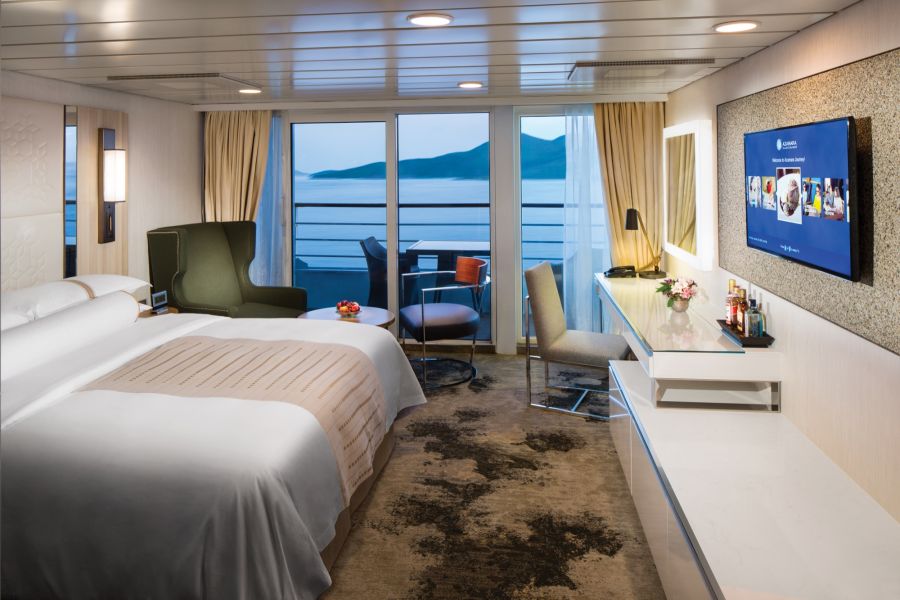
| Grade Code | From | To | |
| N2 | Club Continent Suite (Deck 8, Aft) | £10,930 | £10,930 |
| N1 | Club Continent Suite (Deck 8, Mid) | £11,210 | £11,210 |
The Club Continents suites are our smaller suites, yet spacious and comfortable. These suites, too, are transformed with a completely new décor inspired by nature’s elements of water, sand, wood and stone. They feature two lower beds convertible to queen size, comfortable sitting area, a spacious, newly decorated bathroom – either with a bath tub or shower, large flat-screen TV, mini-bar, and plenty of other fine amenities. A wonderful and refined home away from home.
Features:
Complimentary Features:
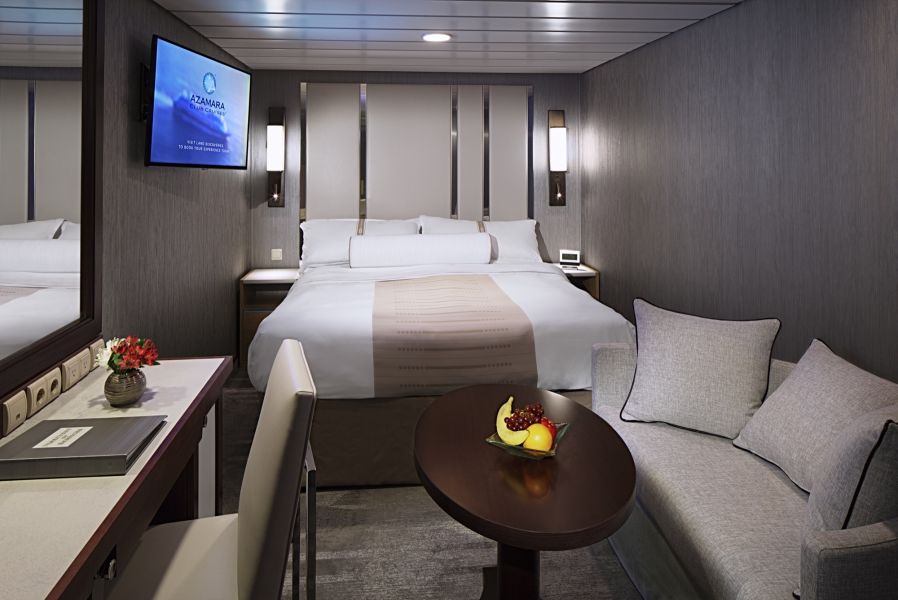
| Grade Code | From | To | |
| 12 | Club Interior Stateroom (Deck 4, Mid) | £5,883 | £5,883 |
| 11 | Club Interior Stateroom (Deck 6,7, Fwd) | £6,065 | £6,065 |
| 10 | Club Interior Stateroom (Deck 7, Mid) | £6,240 | £6,240 |
| 9 | Club Interior Stateroom (Deck 8, Mid/Fwd) | £6,408 | £6,408 |
Welcome to your vacation home with ocean views, sea breezes, and all the style and amenities of a boutique hotel. Relax with plush cotton robes and slippers, French bath products, fresh flowers, and 24-hour room service. Our goal is to make you comfortable so you can spend more time on important things. Like exploring the world.
Features:
Complimentary Features:
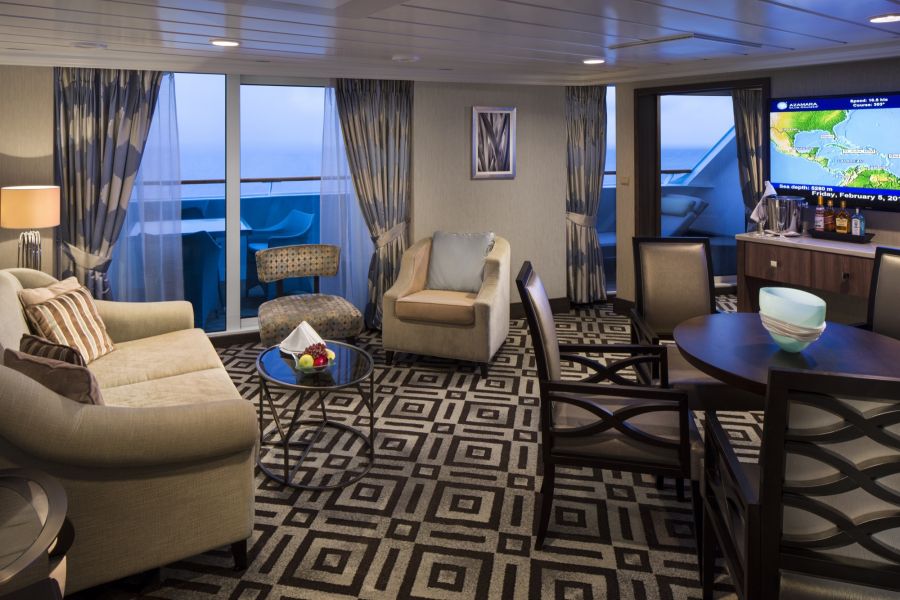
| Grade Code | From | To | |
| CO | Club Ocean Suite | £17,545 | £17,545 |
When you step inside your Club Ocean Suite, you step inside a large suite with elegant, contemporary décor. These suites feature new furnishings and wallpaper, plush carpeting, writings desks and more. With a large living room and a separate bedroom, and floor-to-ceiling sliding glass doors that open to your own private veranda, your suite will be a wonderful respite from your many experiences on land. Marble master bath and dressing room with vanity make it easy and comfortable to get ready for the day—or for an evening dinner out. Large flat-screen television, mini-bar, and other fine amenities add to the comfort of the suite. You’ll be spoiled by the attention to detail in these beautiful suites, and of course, all the pampering, too.
Features:
Complimentary Features:
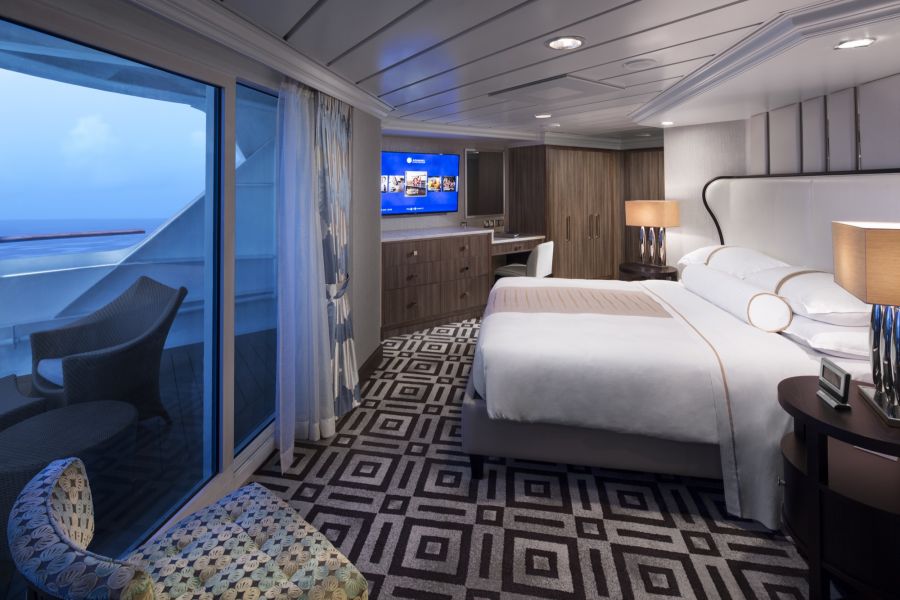
| Grade Code | From | To | |
| CW | Club World Owner's Suite | £19,582 | £19,582 |
Our largest suites have been transformed to feature contemporary design elements that create an elegant and organic feel. The design draws inspiration from nature—a sandy cliff, flowing river beds, exquisite white sand beaches, and rustling grasses.
These luxurious accommodations feature a large living room with a separate bedroom, floor-to-ceiling sliding glass doors that open to your own private veranda, marble master bath, large flat-screen television, mini-bar, and many other amenities. Enjoy everything our Club Owner’s Suites have to offer, and of course, all of the pampering that comes with them.
Features:
Complimentary Features:
The images shown are for illustration purposes only and may not be an exact representation of what you find on the ship.

At Aqualina, you’ll find some of Italy’s most authentic dishes. Pastas made from scratch, traditional and authentic recipes, and scrumptious vegetarian dishes that make sure there’s something for everyone. Savor a traditional Spaghetti Bolognese, enjoy a classic Antipasti or a hearty Fisherman’s Soup or an Eggplant Parmesan to a Rigatoni Pomodoro with fresh veggies. You won’t be able to say no to our famous desserts: Sorrento lemon liqueur mousse, hazelnut chocolate soufflé and more. Our chefs love to be inspired, so after an on-shore visit to a local market, you can also expect a delectable dish so local, you’ll feel like you’re not onboard anymore.
Specialty dining is complimentary for suite guests. For others, there is a $30 per-person cover. Reservations are highly recommended.
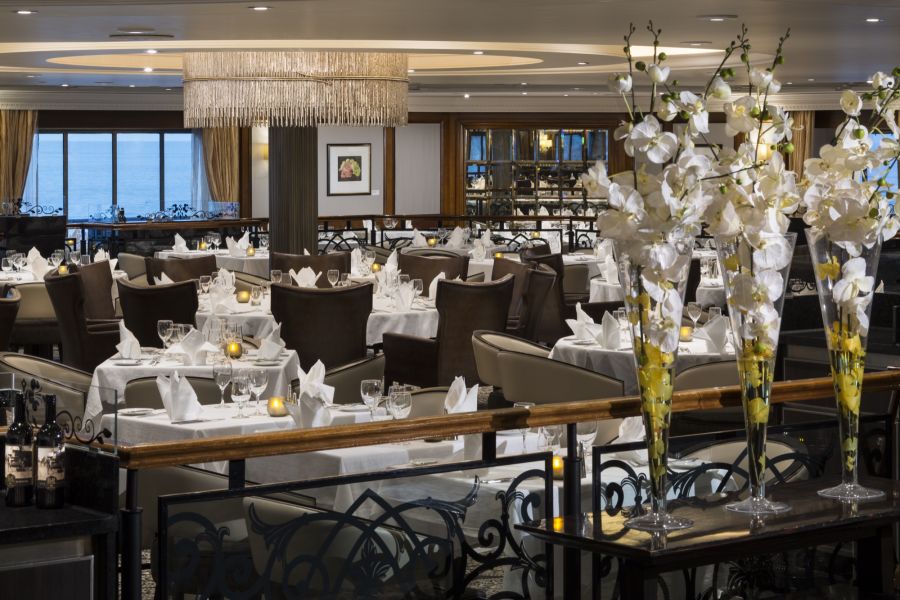
Discover the world through dishes and flavors from the places we visit. Whether it’s our Destination Immersion dinner buffet or the Destination Immersion cuisine on our dinner menu, give your dining a little local flavor and enjoy on shore tastes onboard! Of course, you will also enjoy a wide variety of nightly selections such as filet mignon with black truffle sauce. With its elegant yet lively dining and renewed décor, it’s easy to see why this restaurant is a hands-down favorite, the culinary heart of our ships. Gather at Discoveries Bar for drinks before or after dinner.
Reservations are not accepted. Choose being seated at a table for two or as part of a larger group of fellow guests (which we highly recommend! It’s a great way to meet new people).
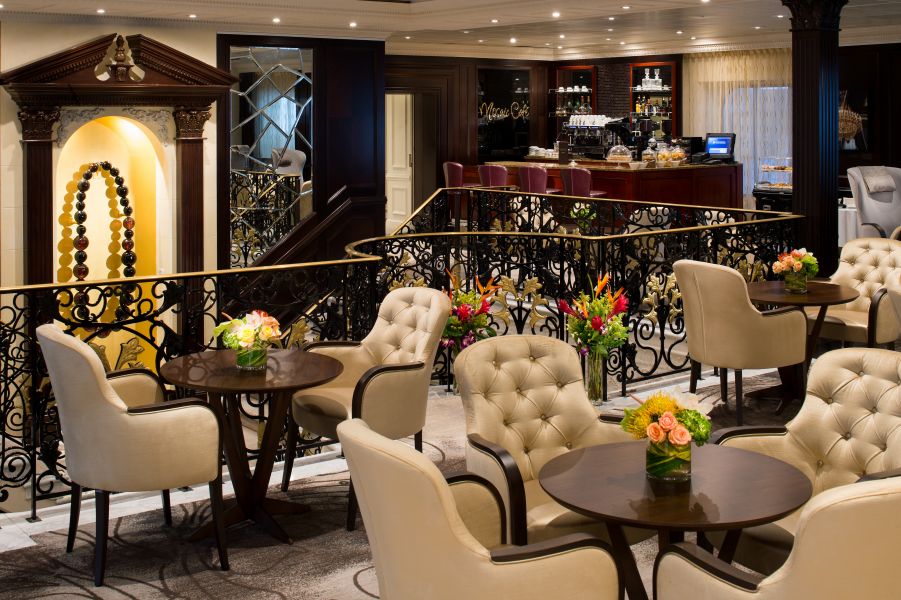
Casual “pool grill” by day. Then, fine tablecloths and flickering candles will set the mood for a sit-down al fresco dining experience by night. Taste your way around the world with exclusive personalized dishes using local flavors of the places we visit on our Destination Immersion® cuisine dinner menu served by our professional wait staff. And for a little touch of whimsy, a self-serve frozen yogurt station—Swirl & Top. With a variety of flavors and your choice of toppings, it’s the perfect way to cool off during the day or end your evening meal.
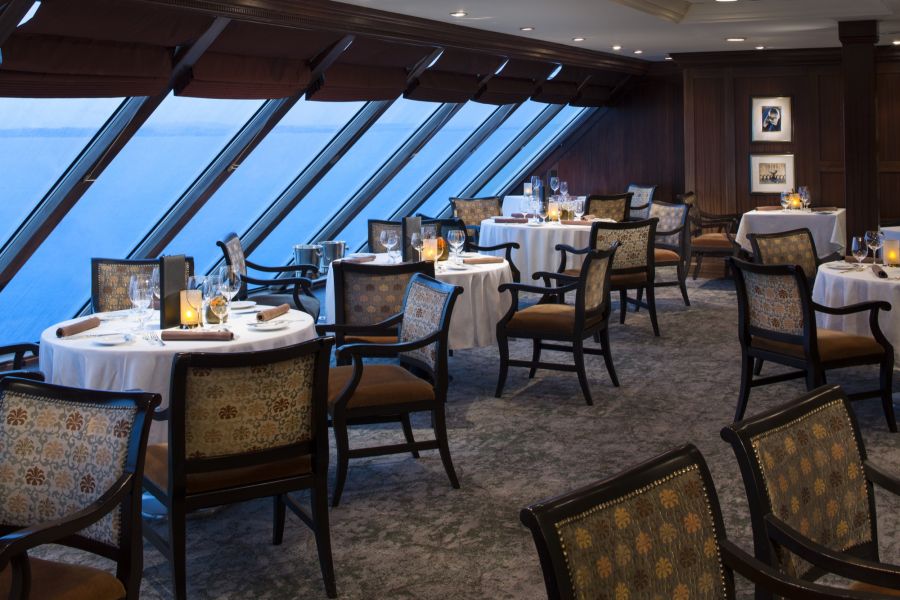
Steaks cooked to perfection. Crab cakes with remoulade. Lobster bisque. Lamb, game hens and seafood. And last but certainly not least, our famous mini cinnamon-sugar donuts with dipping sauces for dessert. (Yes, they are as good as they sound.) But at Prime C, you’re in for more than an array of delectable dining. Expect a marvelous evening in a warm wood-paneled ambiance with stunning views and lush décor. And, if our chef has made a visit to a local market while we’re in port, you’ll also have an authentic local dish to look forward to, made just for you.
Specialty dining is complimentary for suite guests. For others, there is a $30 per-person cover. Reservations are highly recommended.

You’ll be hard-pressed to find such a collection of limited production, small label and rare vintage wines anywhere on the high seas! And with vintages from France to California, and Argentina to South Africa, you’re sure to find a wine to suit your palate. And your journey. Our knowledgeable sommeliers can help you pick the perfect wines for your evening meal—and your voyage!—and be sure to join our Wine Corner gatherings in the Mosaic Café, perfect for discovering and enjoying new wines and benefiting from the thoughtful guidance of our sommelier.
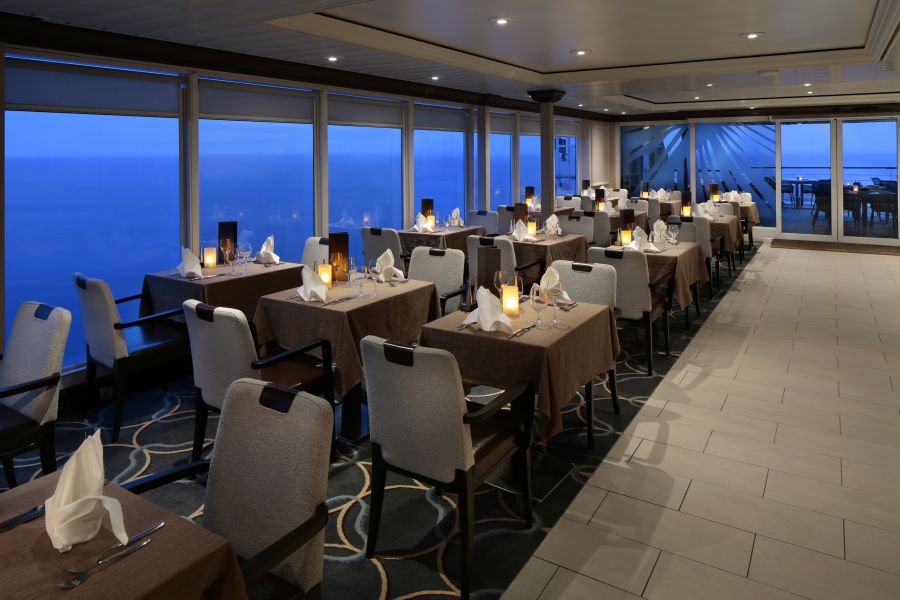
The best way to see where you are in the world is not by looking at your itinerary. It’s by checking out the menu at Windows Café! Our daily themed dinner often takes its inspiration from the region we’re visiting—Indian, Mexican, Spanish, Italian. We also create an extra live station made from local ingredients purchased in port: Greek salad made with local feta (Greece), pasta prepared with local mushrooms (Italy), fresh Mussels served with garlic bread (Netherlands). Take in the fresh breeze at an outdoor table and relax in the easy and casual atmosphere of the newly renovated Windows Café. Enjoy an intimate breakfast, lunch, or dinner for two or a lively meal for six with our flexible seating options. And speaking of choices, selections change daily. Choose from fresh sushi, stir-fry and pasta, salads, smoked lox and other cold fish, a carving station and of course, desserts.
The images shown are for illustration purposes only and may not be an exact representation of what you find on the ship.
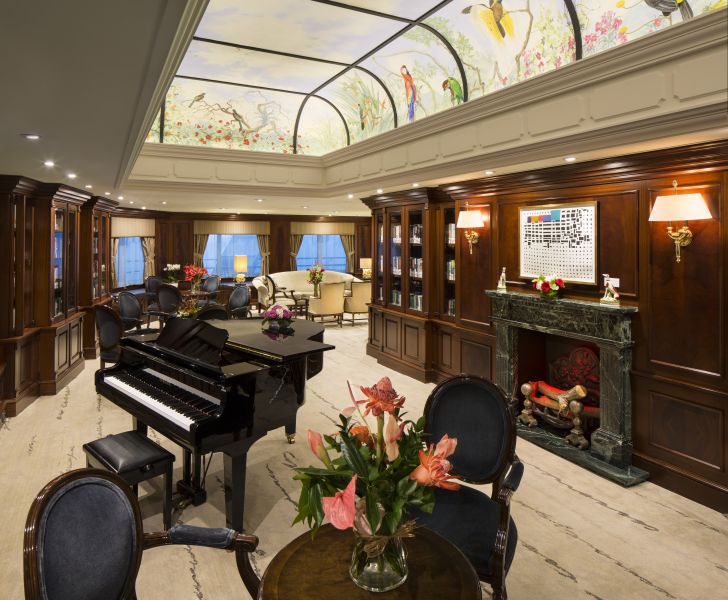
This library is one of the quiet jewels of Azamara, a peaceful and beautifully appointed space for reading or relaxing after dinner. Browse the collection and feel free to borrow the library books. Or simply relax in the tranquil atmosphere. But the library goes beyond just paper, they have interactive digital tabletops so you can make your own postcards and post to social media to share your adventures with the folks back home. The library is also home to their impressive Inspiration Center—a digital way to explore the world with Azamara and gain inspiration for your next voyage.
The Drawing Room turns into a gorgeous dining room on the evening of the elegant Best of the Best dinner for Owner’s Suite guests.
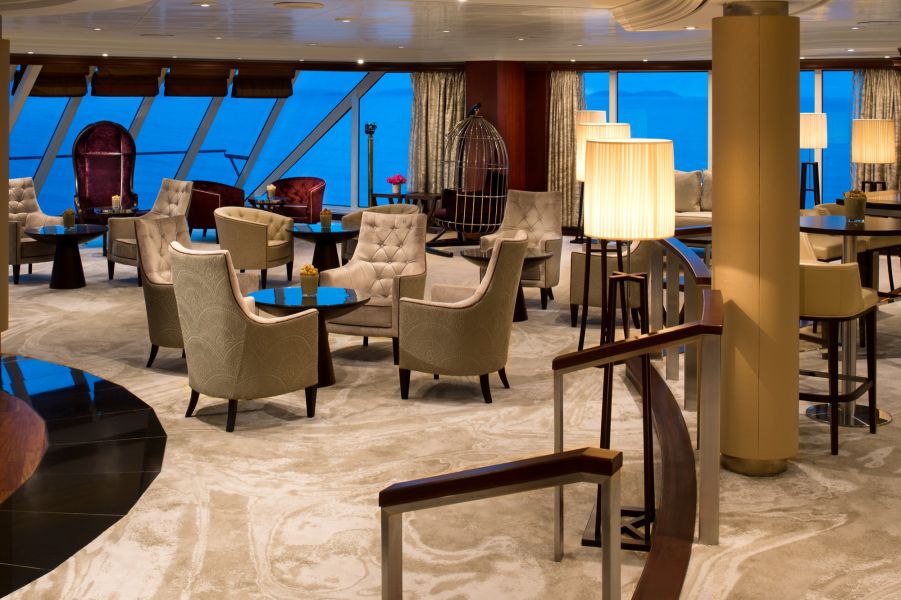
The idea of the Living Room is just that. It’s the perfect space for guests throughout the day and evening to engage in lively conversations, take in interesting speakers, peruse art, play a game of cards, enjoy a cup of tea or coffee, wines & tapas, delightful music, or simply relax with a good book.
Card Room & In Touch
On the starboard side of the Living Room, guests will find the Card Room for those who love a round of Bridge or other games. Four computers and interactive table tops are available for guest use during the voyage.
The images shown are for illustration purposes only and may not be an exact representation of what you find on the ship.
The images shown are for illustration purposes only and may not be an exact representation of what you find on the ship.
| 21 nights aboard the Azamara Journey | |||
| AzAmazing Evenings event on voyages over 7 nights | |||
| Pre-Paid Gratuities | |||
| Select standard spirits, international beers & wines | |||
| Free bottled water, soft drinks, specialty coffees & teas | |||
| Concierge services for personal guidance & reservations | |||
| Free self-service laundry | |||
| Shuttle service to & from port where available | |||
| English Butler Service for suite Guests | |||
| Port Taxes and Fees | |||
 | ABTA and ATOL Protection* | ||
Date 10th Oct 2027 |
Nts 21 |
Interior £5,883pp |
Oceanview £6,408pp |
Balcony £7,766pp |
Suite £10,930pp |
Date 10th Oct 2027 |
Nts 21 |
Interior £5,883pp |
Oceanview £6,408pp |
Balcony £7,766pp |
Suite £10,930pp |
| Interior staterooms from | £5,883pp | ||
| 9 | Club Interior Stateroom (Deck 8, Mid/Fwd) | £6,408pp | |
| 10 | Club Interior Stateroom (Deck 7, Mid) | £6,240pp | |
| 11 | Club Interior Stateroom (Deck 6,7, Fwd) | £6,065pp | |
| 12 | Club Interior Stateroom (Deck 4, Mid) | £5,883pp | |
| Oceanview staterooms from | £6,408pp | ||
| 4 | Club Oceanview Stateroom (Deck 6, Fwd) | £7,087pp | |
| 5 | Club Oceanview Stateroom (Deck 4, Mid) | £6,856pp | |
| 6 | Club Oceanview Stateroom (Deck 4, Fwd) | £6,632pp | |
| 8 | Club Oceanview Stateroom (Deck 6, Obstructed) | £6,408pp | |
| Balcony staterooms from | £7,766pp | ||
| V1 | Club Veranda Stateroom (Deck 4) | £8,326pp | |
| V2 | Club Veranda Stateroom (Deck 7) | £8,046pp | |
| V3 | Club Veranda Stateroom (Deck 6) | £7,766pp | |
| P1 | Club Veranda Plus Stateroom (Decks 6,7,8, Aft/Fwd) | £8,949pp | |
| P2 | Club Veranda Plus Stateroom (Deck 8, Mid) | £8,669pp | |
| P3 | Club Veranda Plus Stateroom (Deck 8, Fwd) | £8,445pp | |
| Suite staterooms from | £10,930pp | ||
| N1 | Club Continent Suite (Deck 8, Mid) | £11,210pp | |
| N2 | Club Continent Suite (Deck 8, Aft) | £10,930pp | |
| CO | Club Ocean Suite | £17,545pp | |
| CW | Club World Owner's Suite | £19,582pp | |
Fusion Cruises when selling travel arrangements is a trading name of The Midcounties Co-operative Ltd. Fusion Cruises is an Accredited Body Member of Midcounties Co-operative Travel Consortium. (ABTA:P6652, ATOL:6053).
Book with Confidence. We are a Member of ABTA which means you have the benefit of ABTA’s assistance and Code of Conduct.
Some of the flights and flight-inclusive holidays on this website are financially protected by the ATOL scheme but ATOL protection does not apply to all holiday and travel services offered on this website. This website will provide you with information on the protection that applies in the case of each holiday and travel service offered before you make your booking. If you do not receive an ATOL Certificate then the booking will not be ATOL protected. If you do receive an ATOL Certificate but all parts of your trip are not listed on it, those parts will not be ATOL protected. Please see our booking conditions for information, or for more information about financial protection and the ATOL Certificate go to: www.caa.co.uk
